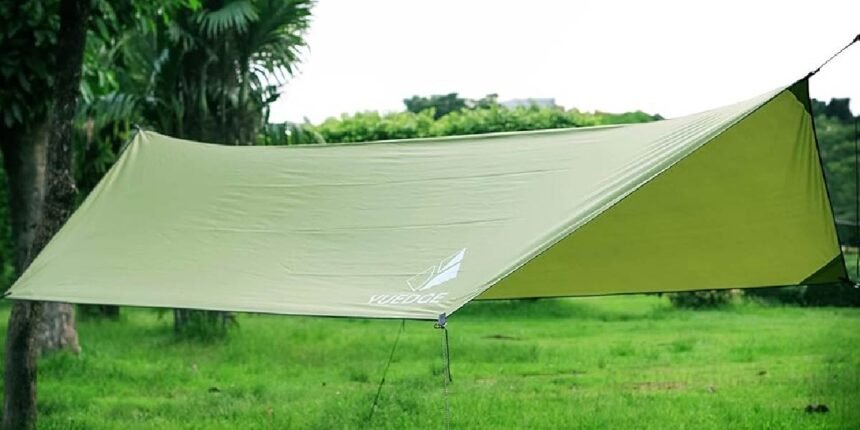Introduction to Tarnplanen
Tarnplanen is a German term that combines “Tarn,” meaning camouflage, and “Planen,” which translates to tarps or covers. In essence, Tarnplanen refers to camouflage tarpaulins—durable and weather-resistant sheets designed for concealment and protection. These camouflage tarps are widely used in military, survival, bushcraft, and outdoor scenarios where blending into the environment is essential. Tarnplanen is much more than a regular tarp.
It is designed not only to offer protection against the elements like rain, sun, and wind but also to provide stealth in various terrains such as forests, deserts, snowfields, and even urban zones. The meaning of Tarnplanen lies in its dual role—it conceals while it protects. Whether used to hide military equipment, set up a survival shelter, or provide privacy in a campsite, Tarnplanen is built for performance and discretion.
This article will explore everything about Tarnplanen, from its history and materials to its modern applications and ethical use, providing a full understanding for anyone interested in outdoor or tactical gear.
History and Origin of Tarnplanen
The origin of Tarnplanen dates back to military operations in early 20th-century Europe, especially in Germany during World War I and World War II. Camouflage techniques were developed to help soldiers and military equipment blend into their environment, preventing detection by enemy forces. One of the key innovations of this era was the introduction of camouflage fabric and tarpaulins that could be draped over tents, vehicles, weapons, and troops.
These military camouflage tarps were essential for survival and success on the battlefield, especially as aerial reconnaissance and long-range weapons became more advanced. Over time, the utility of Tarnplanen extended beyond the military. As war surplus items became available to the public, outdoor enthusiasts, campers, survivalists, and hunters began using Tarnplanen for their durability and concealment features.
Today, while modern camouflage technology has advanced, the original German Tarnplanen remains a staple in both military surplus stores and outdoor gear shops around the world. Its origin speaks of necessity, innovation, and adaptation, making it a product with deep historical significance.
What Is Tarnplanen Used For?
The uses of Tarnplanen are vast and span across various domains, from military to everyday civilian life. In tactical and military settings, Tarnplanen is used to conceal vehicles, camps, personnel, and equipment from enemy view or surveillance systems. Its ability to blend seamlessly into natural surroundings makes it a critical tool for operations in forests, deserts, snowy landscapes, and even urban war zones. In the world of outdoor recreation and survival, Tarnplanen serves as a lightweight, portable shelter that protects users from rain, wind, and sun.
Campers and bushcrafters often use it as a groundsheet, tarp tent, or gear cover. Hunters use Tarnplanen to remain invisible to wildlife, while wildlife photographers rely on it to avoid disturbing animals in their natural habitat. For practical civilian applications, Tarnplanen is used to cover construction materials, protect outdoor tools, or create makeshift roofs.
It’s also popular for use in emergency scenarios, such as flood zones or temporary shelters. Whether for concealment, weather protection, or durable coverage, Tarnplanen proves to be a versatile and indispensable tool in any outdoor setting.
Materials Used in Tarnplanen Construction
Tarnplanen is made from a variety of materials, each selected for durability, performance, and specific use cases. The most common fabrics include polyester and nylon, both known for being lightweight and fast-drying, ideal for camping and wet environments. Nylon offers more durability and tear-resistance, making it a preferred choice for long-term outdoor exposure. Canvas, often used in more traditional Tarnplanen models, provides breathability and strength, although it is heavier than synthetic materials.
For waterproof and easy-to-clean versions, PVC-coated tarps are highly popular. These are smooth, moisture-resistant, and suitable for heavy-duty use in rain or snow. Polyethylene is another common material, known for being cost-effective, UV-resistant, and widely available in civilian markets. In addition to fabrics, Tarnplanen often features advanced coatings and treatments. These include polyurethane (PU) and PVC coatings that make the fabric completely waterproof, and UV-resistant finishes that prevent degradation from prolonged sun exposure.
Some military-grade Tarnplanen also come with fire-retardant treatments for safety in combat or hazardous areas. Reinforcements like metal grommets, corner loops, and ripstop weaving are standard, enhancing the tarp’s strength and allowing easy setup with ropes, pegs, or stakes. These details ensure Tarnplanen remains functional, rugged, and reliable in all conditions.
Features That Make Tarnplanen Unique
One of the standout features of Tarnplanen is its tailored camouflage design, which comes in different patterns suitable for various terrains—woodland, desert, snowy mountains, and even digital urban environments. Unlike traditional tarpaulins, which are usually single-colored and meant just for coverage, Tarnplanen is designed specifically to hide its user or contents from visual detection.
Its camouflage pattern breaks up outlines and makes it hard to distinguish from natural surroundings. Additionally, Tarnplanen is significantly more durable and weather-resistant than ordinary tarps. It is built to withstand high winds, rain, UV rays, and physical wear. The design focuses on visual disruption and concealment through pattern variation and color blending. Moreover, Tarnplanen is lightweight and portable, making it easy to carry during hiking, tactical missions, or emergency evacuations.
Its multi-functional usage—as a groundsheet, shade, windbreaker, or gear cover—makes it highly efficient. In terms of performance, it’s not just about protection from the elements, but also about being unnoticed in your environment. That’s the real value of Tarnplanen—it allows you to survive and thrive without being seen.
Where Is Tarnplanen Commonly Used?
Military & Tactical Operations
Tarnplanen has a strong association with military and tactical operations. From its early days in German military service to its current use by NATO forces, Tarnplanen plays a critical role in field concealment. Troops use it to cover tents, weapon caches, and vehicles to remain hidden from drones, aircraft, and ground surveillance. Military surplus Tarnplanen, known for their strength and reliability, are still in circulation and are often sought after by collectors and survivalists.
Outdoor Survival & Bushcraft
In outdoor survival and bushcraft communities, Tarnplanen is a go-to gear item. Its ability to serve as both a shelter and concealment tool makes it a top choice for campers, hikers, and preppers. Whether you’re setting up a fast lean-to shelter, creating a dry ground cover, or building a windbreak in the forest, Tarnplanen does the job efficiently. It’s light enough to carry in a backpack and durable enough to handle the toughest outdoor conditions.
Commercial & Civilian Use
Tarnplanen is not just limited to tactical or wilderness use. In commercial settings, it’s used to protect goods during transport or storage. Roofing contractors, gardeners, and mechanics use Tarnplanen to shield equipment from the weather. Truck drivers use it to protect cargo from the sun and rain. DIY enthusiasts and homeowners use it for temporary covers during renovations or repairs. Its practicality makes it popular even in urban environments.
Choosing the Right Tarnplanen – Buying Guide
Selecting the right Tarnplanen depends on your intended use, the environment, and your durability needs. First, consider the size and shape. Smaller Tarnplanen are suitable for solo campers or gear covers, while medium ones work for family tents or group shelters. Large Tarnplanen can cover vehicles, full campsites, or serve as community shelters. Next, evaluate the material—PVC-coated tarps are ideal for waterproof protection; canvas ones are breathable and durable for repeated use; polyethylene versions are lighter and more affordable.
Camouflage pattern also matters. Choose based on the terrain where you’ll use the tarp: woodland for forests, beige for deserts, white for snow, and digital camo for urban areas. Durability indicators such as GSM (grams per square meter), reinforced seams, and strong grommets are important. Look for military-grade or UV-certified options for the best performance. Finally, purchase from trusted sellers—military surplus outlets, outdoor gear retailers, or reputable e-commerce platforms like Amazon or eBay. Look for product listings with detailed specs and strong customer reviews.
How to Use Tarnplanen Effectively
Shelter Building Techniques
When building a shelter, use grommets and ropes to secure Tarnplanen between trees or poles. Common setups include A-frame, lean-to, and ridgeline designs. Always angle your tarp to allow water runoff. Use rocks or pegs to anchor the bottom edges, especially in windy weather. The versatility of Tarnplanen allows you to build improvised shelters quickly, whether for shade, rain protection, or overnight camping.
DIY Project Tips
Tarnplanen is also useful in backyard and DIY projects. You can use it to create sunshades, privacy screens, or protect your gear and furniture during outdoor work. Some DIYers turn Tarnplanen into custom gear bags, ponchos, or car covers. Its flexibility and durability allow for creative and practical applications beyond camping or military use.
Cleaning and Storage
Maintaining your Tarnplanen is crucial for longevity. Clean it with mild soap and cold water—never use bleach or harsh detergents. Let it dry completely before folding to avoid mildew. Store it in a cool, dry place out of direct sunlight. Regularly inspect grommets and seams for wear, and patch any small tears to prevent them from growing. With proper care, Tarnplanen can last for many years.
Tarnplanen in Wildlife & Photography
For wildlife photographers and naturalists, Tarnplanen is an essential piece of equipment. Its camouflage helps them stay hidden while observing or capturing animals in their natural behavior. Being able to remain invisible in the wild allows for better shots and less stress on animals. Photographers can use Tarnplanen to build blinds or cover their gear, ensuring they don’t disrupt the environment while still getting the perfect shot. Its reusability and portability make it an eco-friendly option for fieldwork.
Tarnplanen in Art and Cultural Use
Interestingly, Tarnplanen has found its way into the world of art and eco-conscious design. Artists use camouflage tarpaulins in outdoor installations to explore themes like invisibility, survival, and environmental integration. Some fashion designers even incorporate camouflage fabric inspired by Tarnplanen into streetwear and performance art. This crossover into culture shows how functional objects like Tarnplanen can carry deeper symbolism and inspire creative expression.
Tarnplanen vs Traditional Tarpaulins – Comparison Table
| Feature | Tarnplanen | Traditional Tarpaulin |
|---|---|---|
| Purpose | Camouflage + Protection | Basic cover/protection |
| Material | Camouflage canvas/PVC blends | Polyethylene, plastic |
| Waterproof/UV-Resistant | Yes (often multi-coated) | Sometimes |
| Design | Terrain-matched camouflage | Single-color/plain |
| Weight | Lightweight & packable | Varies |
| Durability | Military-grade, reinforced | Moderate to low |
| Visibility Concealment | High | Low |
Ethical Use and Considerations
Using Tarnplanen ethically is important, especially in sensitive environments. Always follow local laws when using camouflage gear in nature reserves, hunting zones, or military zones. Do not use Tarnplanen for illegal surveillance, unauthorized hunting, or trespassing. Respect wildlife by observing from a distance without causing distress. Responsible use ensures Tarnplanen remains a helpful and respected tool rather than a controversial one. It’s essential to promote a culture of ethical outdoor practices and environmental stewardship while using Tarnplanen.
Conclusion
Tarnplanen is more than just a camouflage tarp—it’s a reliable, multi-use outdoor tool with applications in survival, protection, and concealment. Its military-grade construction, weather resistance, and portability make it suitable for soldiers, bushcrafters, preppers, campers, and anyone who values outdoor readiness. Whether you need to stay hidden, dry, shaded, or warm, Tarnplanen has you covered—literally and figuratively. With the right selection, care, and ethical use, Tarnplanen can serve you for years, proving to be a vital part of your gear in any scenario. It truly represents the perfect union of simplicity, performance, and camouflage functionality.
FAQs About Tarnplanen
What is Tarnplanen used for?
Tarnplanen is used to hide and protect people, equipment, or shelters in outdoor settings. It is mainly used in military, camping, survival, hunting, and bushcraft to stay hidden and safe from weather like rain, wind, and sun.
Is Tarnplanen waterproof and weather-resistant?
Yes, Tarnplanen is usually waterproof and made to handle harsh outdoor conditions. Most versions have special coatings to protect against rain, sunlight (UV), wind, and even snow, making them great for long-term outdoor use.
What material is Tarnplanen made from?
Tarnplanen is made from strong materials like polyester, nylon, canvas, and PVC-coated fabric. These materials make it durable, tear-resistant, and perfect for outdoor or tactical environments.
Can I use Tarnplanen for camping?
Yes, Tarnplanen is perfect for camping. You can use it as a tent cover, groundsheet, rain shelter, or wind barrier. Its camouflage design helps it blend into nature while keeping you dry and protected.
How is Tarnplanen different from a regular tarp?
Tarnplanen is stronger, camouflaged, and made for outdoor survival compared to regular tarps. It lasts longer, offers better protection, and helps you stay hidden in forests, deserts, or other outdoor areas.
For More Information Visit Fourmagazine







